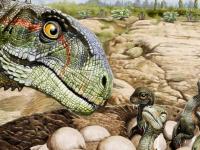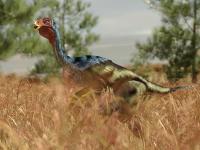How Do We Know What Color Dinosaurs Were?
There are some things we might never know about dinosaurs. What colors were they? What did they sound like? How did T. rex apply sunscreen? Lucky for us, science is there to answer those questions. Well, one of them, anyway.
Rainbowsauruses
It's just common sense that you can't tell what color dinosaurs were, right? After all, it's not like you'll be able to see greens and oranges on fossilized bones (and even if you could, that would just tell you what color their bones were). Sure, there are also skin imprints that tell us if they were scaly, like Triceratops, or feathered, like Velociraptor, but those are just shapes in the mud. They aren't enough to tell you what they really looked like.
But in 2010, a close examination of the feathers of Sinosauropteryx resulted in a surprising reveal. Discovered in 1996, Sinosauropteryx was the first dinosaur we found with feathers (though that might be splitting hairs since the line between bird and dino is notoriously blurry). When examined under a microscope, however, those feathers were found to have surviving melanosomes: the tiny, cellular organelles that generate melanin, and thus, pigment.
Even so, big deal, right? After all, we could have assumed that those dinos hadmelanosomes — it's not as if we assumed they were colorless. But the whole reason they decided to look at Sinosauropteryx's feathers in the first place was a discovery that made the color-producing process a lot less mysterious.
Melano-So Much for Green Scales
You'll find melanosomes in pretty much every animal, but it wasn't until 2008 that a team of researchers from Yale began looking for them in fossilized birds as well. They did so with an eye toward comparing them to modern birds, and what they found indicated the relationship between the physical shape of the melanosomes and the pigment that they would produce. One 40-million-year-old specimen, for example, was found to have iridescent qualities, since differently-shaped melanosomes were found arranged in a staggered pattern that would appear different depending on what angle they were viewed from.
So what color were dinosaurs? For now, we can't answer that question for every dino, but when it comes to Sinosauropteryx, the picture is nearly complete. And very raccoon-like. These little beasts, which were only about a meter (three feet) long, had a robber mask around their eyes, dark, reddish coloration on their backs, a pale belly, and long striped tails.
In its own way, it's not too surprising that a dinosaur would bear such a close resemblance to a living animal it has no relation to — color patterns evolve because they work, and because they work, they evolve more than once. So the next time you think of dinosaurs, picture your raptors with leopard prints, your duckbills with zebra stripes, or your ornithomimuses with bright blue peacock plumage.
Want to see more out-there dinosaur colors? Check out Kazuo Terakado's "The Art of the Dinosaur" for some images from the world's top paleoartists. We handpick reading recommendations we think you may like. If you choose to make a purchase through that link, Curiosity will get a share of the sale.
Source: https://curiosity.com









